
Ecdysis is the moulting of the cuticle in many invertebrates of the clade Ecdysozoa. Since the cuticle of these animals typically forms a largely inelastic exoskeleton, it is shed during growth and a new, larger covering is formed. The remnants of the old, empty exoskeleton are called exuviae.

Metamorphosis is a biological process by which an animal physically develops after birth or hatching, involving a conspicuous and relatively abrupt change in the animal's body structure through cell growth and differentiation. Metamorphosis is iodothyronine-induced and an ancestral feature of all chordates. Some insects, fishes, amphibians, mollusks, crustaceans, cnidarians, echinoderms, and tunicates undergo metamorphosis, which is often accompanied by a change of nutrition source or behavior. Animals that go through metamorphosis are called metamorphoses. Animals can be divided into species that undergo complete metamorphosis ("holometaboly"), incomplete metamorphosis ("hemimetaboly"), or no metamorphosis ("ametaboly").
Biologically, an adult is a human or other organism that has reached sexual maturity. In human context, the term adult additionally has meanings associated with social and legal concepts. In contrast to a "minor", a legal adult is a person who has attained the age of majority and is therefore regarded as independent, self-sufficient, and responsible. The typical age of attaining legal adulthood is 18, although definition may vary by legal rights and country.

The black-necked grebe, known in North America as the eared grebe, is a member of the grebe family of water birds. It was described in 1831 by Christian Ludwig Brehm. There are currently three accepted subspecies, including the nominate subspecies. Its breeding plumage features a distinctive ochre-coloured plumage that extends behind its eye and over its ear coverts. The rest of the upper parts, including the head, neck, and breast, are coloured black to blackish brown. The flanks are tawny rufous to maroon-chestnut, and the abdomen is white. When in its non-breeding plumage, this bird has greyish-black upper parts, including the top of the head and a vertical stripe on the back of the neck. The flanks are also greyish-black. The rest of the body is a white or whitish colour. The juvenile has more brown in its darker areas. The subspecies californicus can be distinguished from the nominate by the former's usually longer bill. The other subspecies, P. n. gurneyi, can be differentiated by its greyer head and upper parts and by its smaller size. P. n. gurneyi can also be told apart by its lack of a non-breeding plumage. This species is present in parts of Africa, Eurasia, and the Americas.
A young adult is generally a person ranging in age from their late teens or early twenties to their thirties, although definitions and opinions, such as Erik Erikson's stages of human development, vary. The young adult stage in human development precedes middle adulthood. A person in the middle adulthood stage ages from 40 or 41 to 64. In old age, a person is 65 years old or older.

In biology, moulting, or molting, also known as sloughing, shedding, or in many invertebrates, ecdysis, is the manner in which an animal routinely casts off a part of its body, either at specific times of the year, or at specific points in its life cycle.

Sarcoptes scabiei or the itch mite is a parasitic mite that burrows into skin and causes scabies. The mite is found in all parts of the world. Humans are not the only mammals that can become infected. Other mammals, such as wild and domesticated dogs and cats as well as ungulates, wild boars, bovids, wombats, koalas, and great apes are affected.

Homarus is a genus of lobsters, which include the common and commercially significant species Homarus americanus and Homarus gammarus. The Cape lobster, which was formerly in this genus as H. capensis, was moved in 1995 to the new genus Homarinus.

Plumage refers both to the layer of feathers that cover a bird and the pattern, colour, and arrangement of those feathers. The pattern and colours of plumage differ between species and subspecies and may vary with age classes. Within species, there can be different colour morphs. The placement of feathers on a bird is not haphazard, but rather emerge in organized, overlapping rows and groups, and these feather tracts are known by standardized names.
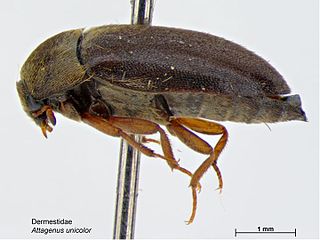
The black carpet beetle is a 3–5-millimetre-long (0.12–0.20 in) beetle that can be a serious household pest. The larvae grow to 7 mm (0.28 in) in length, are reddish brown in colour and covered with bristles. The larval form feeds on natural fibres, damaging carpets, furniture and clothing.

Flight feathers are the long, stiff, asymmetrically shaped, but symmetrically paired pennaceous feathers on the wings or tail of a bird; those on the wings are called remiges, singular remex, while those on the tail are called rectrices, singular rectrix. The primary function of the flight feathers is to aid in the generation of both thrust and lift, thereby enabling flight. The flight feathers of some birds have evolved to perform additional functions, generally associated with territorial displays, courtship rituals or feeding methods. In some species, these feathers have developed into long showy plumes used in visual courtship displays, while in others they create a sound during display flights. Tiny serrations on the leading edge of their remiges help owls to fly silently, while the extra-stiff rectrices of woodpeckers help them to brace against tree trunks as they hammer on them. Even flightless birds still retain flight feathers, though sometimes in radically modified forms.

The inland thornbill, called the broad-tailed thornbill, is a small, insect-eating bird of Australia. The inland thornbill is commonly confused with the coastal brown thornbill due to its similar colorations. The inland thornbill encompasses four subspecies:
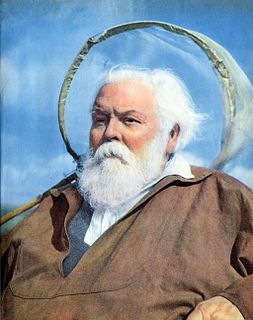
Eugène Le Moult was a French naturalist and entomologist specialised in butterflies; hunter, businessman and collector.
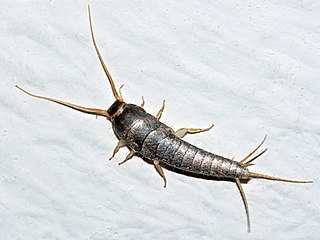
A silverfish is a small, wingless insect in the order Zygentoma. Its common name derives from the animal's silvery light grey colour, combined with the fish-like appearance of its movements. However, the scientific name, indicates the silverfish's diet consists of carbohydrates such as sugar or starches.
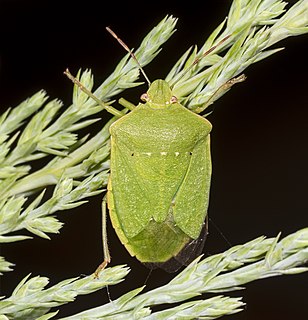
Nezara viridula, commonly known as the southern green stink bug (USA), southern green shield bug (UK) or green vegetable bug, is a plant-feeding stink bug. Believed to have originated in Ethiopia, it can now be found around the world. Because of its preference for certain species of legumes, such as beans and soybeans, it is an economically important pest on such crops.
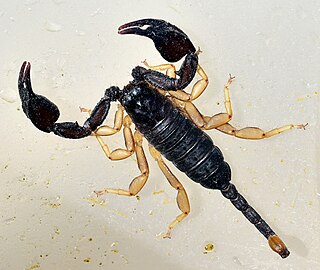
Euscorpius flavicaudis, or the European yellow-tailed scorpion, is a small black scorpion with yellow-brown legs and tail (metasoma). Adults measure about 35–45 mm (1.4–1.8 in) long. It is a fossorial scorpion with relatively large, strong claws (pedipalps) and a short, thin tail.

Crustaceans may pass through a number of larval and immature stages between hatching from their eggs and reaching their adult form. Each of the stages is separated by a moult, in which the hard exoskeleton is shed to allow the animal to grow. The larvae of crustaceans often bear little resemblance to the adult, and there are still cases where it is not known what larvae will grow into what adults. This is especially true of crustaceans which live as benthic adults, more so than where the larvae are planktonic and therefore more easily caught.

Balanus balanus is a species of acorn barnacle in the Balanidae family. It is native to the colder seas of the northern hemisphere.
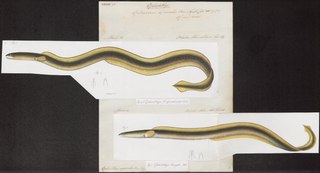
The bluntnose snake-eel is an eel in the family Ophichthidae. The author of the species is anonymous, but it has been referred to Edward Turner Bennett in 1830. It is a tropical, marine eel which is known from the Indo-Pacific, including Kenya, Madagascar, South Africa, Taiwan, Thailand, and the Philippines. It dwells at a maximum depth of 22 m, but also frequents shores. Males can reach a maximum total length of 45 cm.

Hookworms are intestinal, blood-feeding, parasitic roundworms that cause types of infection known as helminthiases. In humans, hookworm infections are caused by two main species of roundworm belonging to the genera Ancylostoma, and Necator. In other animals the main parasites are species of Ancylostoma.
















